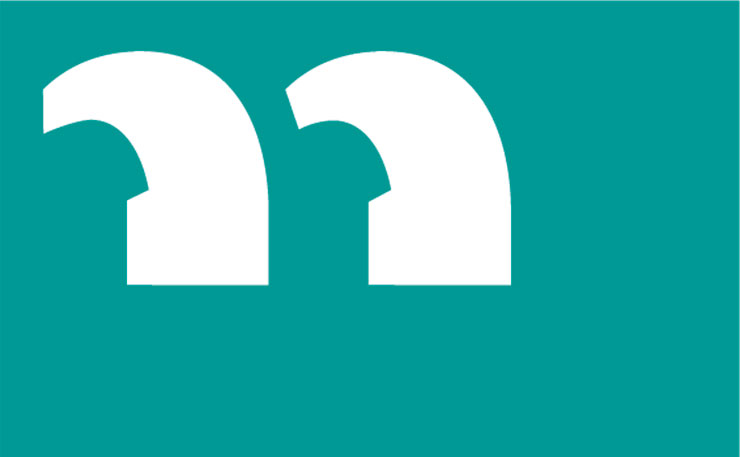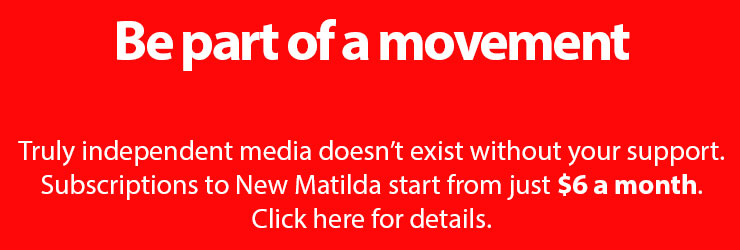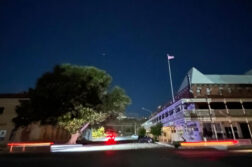In May 2014, while waiting for takeaway coffees in the dining room of a sunlit Glebe café, I experienced something I have since read is common among journalists.
Pacing back and forward, hands fidgeting, I felt a deep churn in my stomach. Moments before arriving at the café I’d sent an email to the Prime Minister’s daughter.
“I’m a journalist with the online publication New Matilda. Today we’re filing a story which involves your studies at the Whitehouse Institute,” it said.
“We intend to post the story by 1pm today. Before we do so, we have a few questions to put to you, as following.”
That morning was the first time I had been forced to fully consider the ramifications of working stories that will provoke anger among people with real power. While I waited for the coffees to emerge I contemplated what kind of trouble it would cause for Frances Abbott – as well as for us.
There was a second consideration, however, begetting a deeper anxiety. What if we were wrong?
That was the day we published our first story based on leaked documents which cast doubt that the PM’s daughter had been given a tertiary scholarship on merit alone. We were narrowly scooped by the Guardian, who first broke the news. But with the internal documents we were able to add compelling evidence to the story, as well as reveal other problems with the private college.
As it turned out, retribution would not be dished out against me or New Matilda (except in one bizarre front page story run by The Australian claiming we had been involved in a plot to bring down the Prime Minister). Instead it was focused on our source Freya Newman, the young woman who had disclosed the documents and was eventually charged with unauthorised access to restricted computer data.
Today – after three years, hundreds of articles, dozens of crowdfunding campaigns, a privately settled defamation case, and one non-conviction and good behaviour bond (go Freya!) – is my last day at New Matilda.
When I started in 2013 I was subbing and fact-checking articles for then owner Marni Cordell. Marni was the first person to give me a paid gig in journalism, and also the first great journalist I got see work up close. Shortly before moving on from NM she published this story, the morning after protests on Manus Island led to the vicious backlash that left Reza Barati dead. Immigration Minister Scott Morrison said the Iranian been killed after escaping the centre; Marni reported that was not the case. As Morrison later admitted, and as the government’s own report would find, Marni was right.
I was lucky to be able to see journalism like this being done, but doubly so because NM put me in touch with more experienced hands who wanted to pass on their skills and passion. Aside from all other obstacles to entry, it’s easy for young journalists to feel their industry is a cynical one, powered largely by precarious egos. Meeting people like Marni, as well as Wendy Bacon, convinced me this was not always the case.
In May 2014 Chris Graham took over the publication. Once something more like a policy portal, then an independent journalistic endeavour, it now pivoted to a hybrid-tabloid style, mixing thorough investigations, detailed environment and Aboriginal affairs reporting, and grabbier, more aggressive stories and comment.
The Frances Abbott story was Chris’ first week in charge.
Since then, the publication has been imprinted with Chris’ distinctive style. This put a not insignificant number of former readers offside immediately. It also saw overall traffic levels massively increase, and awareness of the publication spread. As with his predecessor, Chris invested time, money, and energy into letting young journalists and writers improve.
For me, this manifest in what was undoubtedly the best contribution I made while working here.
In 2014 I started writing stories about offshore detention, including the mistreatment of a group of unaccompanied minors detained on Nauru. The stories barely provoked any attention and garnered negligible amounts of traffic. But I was encouraged to keep writing them as this was an issue Chris and the publication cared about. These were not big stories but they were important, adding detail to a picture governments work so hard to keep unseen. They’re the kind of stories you’re most likely to miss because they don’t find a wide audience on social media.
Working on those stories allowed me to build contacts and trust, and work towards another stomach churning morning in Glebe.
Just under two years after Marni published her account of the violence against refugees held on Manus I was leaked raw transcripts from the government’s inquiry into allegations of sexual assault on Nauru, known as the Moss Review. As a result we published stories which showed, among other things, that a senior member of the Department of Immigration was critical of Morrison’s handling of the fallout after Barati’s murder. Our reporting of the transcripts showed just how nervous and paranoid Morrison and the Department were about their own system, and added insights and evidence to the public record which were not included in the final report issued by Philip Moss.
On the day we broke the back of the first story I worked with Chris for 21 hours, virtually uninterrupted. I was convinced of the veracity of the documents – but how sure is sure? At about 2am, desperately trying to decide what the lede for the story should be, that question overwhelmed me momentarily and the sick-in-the-stomach feeling set in again.
Eventually we satisfied our doubts and published, sharing the material with Guardian Australia to help it gain broader exposure.
This is the best of New Matilda. Behind reports like that one sit the thousands of smaller pieces few people notice, the ones that don’t shock or appal enough to travel across social media.
Amy McQuire – another person who encouraged my faith in journalism and journalists – will be best known to many for her scorching take town of Annabel Crabb’s Kitchen Cabinet, one of the most popular pieces we’ve ever published. Behind this piece are countless articles on the Bowraville murders, Aboriginal deaths in custody, Cape York, the Intervention, child removals, attacks on land rights and sacred sites, and the Recognise campaign. Sometimes these would find significant audiences, sometimes they would not. All of them helped build a picture and nourish important debates about the treatment and position of First Nations people in this country, and the extent to which structural racism still interferes with the lives of so many. (Amy shouldn’t be pigeonholed by any means, she has written about a range of issues including the media, climate change, and West Papua as well). Amy pushed ahead because she, and the publication, cared about these people and these issues.
This is an important point when trying to grapple with NM. It also helps explain why important stories will keep coming across the publication’s desk, so long as it continues to publish.
One of the most telling things about working at New Matilda has been seeing how such stories end up here. There have been, in my experience, two types of people who leak to the publication, or who push us to chase a story. The first type do it because they don’t trust other outlets with the story. The second do it because they have tried to alert larger competitors, only to be ignored.
That’s why New Matilda remains essential. There are plenty of criticisms I have of the publication. Its gender balance, for instance, is terrible, something that has clearly had an impact on editorial decisions. There were days when we went too far.
Being an aggressive, confident, and genuinely independent outlet can be a double-edged sword that way. On one hand, it means you might be the only ones to say, stuff it, let’s publish the Barry Spurr emails. It means that you push where others won’t, or can’t. It means you know you are going to get sued but publish anyway.
On the other hand, it also means that on the day you get it wrong your mistake is likely to be compounded. The independent mentality suddenly plays against you.
What I’ve realised is that the successes and excesses of outlets like New Matilda can’t be separated; they’re expressions of the same core instincts. When it works, there is a delicate balance; the sober analysis of Ben Eltham and the biting commentary of Chris Graham; the clickable far-right outrage bits and drier reports that contradict their assertions; the stuff that other outlets run and the stuff they won’t touch.
This is a balance that can be easily tipped. Too far one way and you lose your reach and distinctive purpose. Too far the other, you hurt your own credibility and inspire masses of criticism.
For us, part of that criticism has derived from our own critiques of other media outlets. This was something I initially felt uncomfortable about – what pedestal do I have to preach from? Over time, my view has changed.
There will never be enough resources in the independent/alternative media to replace the bastards, so to speak. We can’t all lose $30 million a year or rely on public funding to flow through the front door. But we can cast a critical eye on those who do. As Amy’s Kitchen Cabinet piece showed, there are plenty of people hungry to read such critiques. As Chris’ reporting on Lateline makes clear, there are also dirty secrets that need to be exposed.
This can appear sanctimonious, and perhaps at times it is. But who cares? The public broadcaster has been subject to a ferocious, decades long campaign on behalf of private media interests intent on pushing it to the right or destroying it completely. Private media companies are grappling with an environment that has depleted their resources and reorganised their priorities. If public criticism is only made from one side during this period of transformation, the industry is only going to move in one direction.
It’s all well and good to tut-tut the Andrew Bolts of the world, but someone has to get down in the trenches with them.
The reason that Chris, Amy, Ben, and Wendy write about the media is the same as the reason they write about government toll roads, vocational education providers, and cuts to welfare: they care about the impact these things have on people.
That’s why New Matilda has lasted this long: the people who make it and who read it care. From brilliant cartoonist Fiona Katauskas, to fiery columnist Michael Brull, to unsung hero Ange Nicholson, to workaholic editor Chris, it’s an outlet that will continue the weary slog against public indifference towards racism and inequality.
That’s why on my last day I’d ask you to do something I have been asking people to do since 2013 and help the publication fight on another day.
New Matilda takes its chances. It gets things wrong. It lives with a constant feeling of sick in its stomach.
If it disappeared, who would be crazy brave enough to replace it?
Donate To New Matilda
New Matilda is a small, independent media outlet. We survive through reader contributions, and never losing a lawsuit. If you got something from this article, giving something back helps us to continue speaking truth to power. Every little bit counts.





